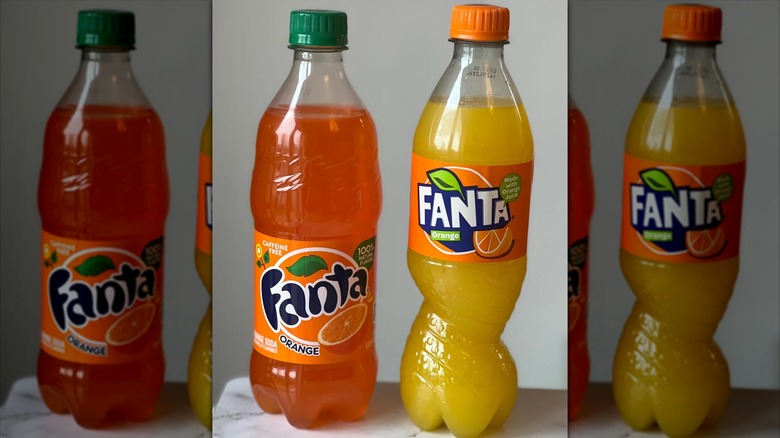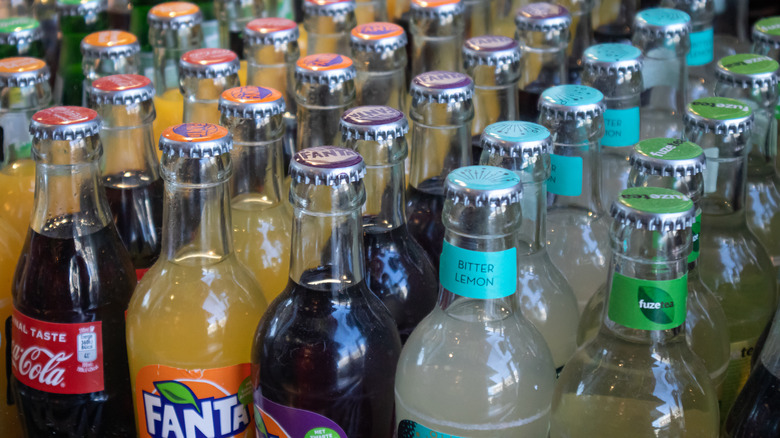The Popular Fizzy Beverage Tourists Notice Has A Bizarrely Different Look In Europe
Many foods and drinks look and taste different abroad, from Belgian chocolate (Europe's best-kept secret) and Italian tomatoes to fresh Greek cheese and young French wine. Now, if you've ever traveled to Europe and ordered a Fanta, you might have noticed something surprising when the bright orange beverage was poured into your glass. The Fanta you get in Europe doesn't just look different from its American counterpart — it tastes different, too. This fizzy, citrus-flavored drink, loved by millions worldwide (particularly in Europe, Africa, and Latin America), undergoes a significant transformation when it crosses the Atlantic. But what exactly makes European Fanta so different, and why does it have a bizarrely different look and flavor compared to the version most Americans are familiar with?
@joeywellness Is Fanta in Europe Healthier than Fanta in America? #suga #sugar #soda #fanta #pop #health #fyp
It helps to start with a brief history of the drink itself. Fanta was originally created in Nazi Germany during World War II as a response to the embargo on the mythical, top-secret formula of Coca-Cola syrup, which was necessary to produce Coca-Cola. With the essential ingredients unavailable, Max Keith, the head of Coca-Cola's operations in Germany, developed a new drink using available ingredients like whey and apple fibers. The result was Fanta, named after the German word "fantasie," meaning imagination. Fanta completely dominated the beverage market during the war, and by 1943, 3 million cases had been sold. After the war, Fanta's formula evolved. By 1955, it first debuted in Italy; then, in 1958, it arrived in America with an orange flavor that became the standard.
Ingredients and the color difference of Fanta
Today, Fanta is available in a variety of flavors, like berry, peach, and even limited-time dragonfruit, but the classic orange version remains the most popular. However, in many European countries, like the United Kingdom, Italy, and Spain, Fanta has a pale, natural orange color — in contrast to the neon, radioactive-looking orange hue in the United States. How come? Food additives. European Fanta contains different ingredients because of the regulations governing food additives in Europe versus the U.S.
In America, Fanta is colored with Yellow 6 (petroleum-derived) and Red 40 (naphthalene sulfonic acid), artificial food dyes that give the drink its vivid appearance. These synthetic dyes are widely used in American food products but have faced scrutiny over potential health risks like cancer, ADHD, and allergies (per Healthline). The list of American ingredients also includes carbonated water, high fructose corn syrup, and less than 2% of: citric acid, natural flavors, sodium benzoate, modified food starch, and glycerol ester of rosin. For an "orange" drink, it sure is missing orange juice.
In Europe, food regulations are much stricter when it comes to artificial additives. The European Union mandates warning labels and restrictions on the use of certain artificial colors and preservatives, and as a result, many companies use natural, less harmful colorings. Fanta in the U.K., for example, is colored with carrot, pumpkin, and orange fruit extracts, which give it a more muted, natural orange shade.
Taste the difference and consumer preferences
Color isn't the only thing differentiating European Fanta from its American counterpart. European Fanta has a more pronounced, authentic orange flavor with a slightly tangy or less sweet profile compared to the American version. The reason comes down to variation in the recipe. American Fanta has 73 grams of sugar per bottle, while U.K. Fanta has only 22.5 grams, and Italy has 59 grams. In the U.S., Fanta is sweetened with high-fructose corn syrup, a ubiquitous sweetener in American sodas known for its intense sweeter-than-sugar sweetness.
Fanta in Europe is sweetened with regular sugar, which gives it a more natural and subtle sweetness. Moreover, European Fanta contains a higher percentage of orange juice (from concentrate) — sometimes as much as 10% or more, depending on the country. The inclusion of fruit juice renders a natural orange flavor and also results in a less sickly-syrupy texture, making the drink more refreshing. The American version contains 0% fruit juice.
But ... Why? Europeans favor products with natural ingredients and unashamedly scrutinize food labels for additives. Movements like the Italian zero-kilometer meal exist for a reason. This has driven companies like Coca-Cola to adapt their products, resulting in a Fanta that is more in line with European tastes and regulatory standards. In contrast, the American market is more accepting of artificial ingredients, so American Fanta reflects these preferences. Next time you go to Europe, try the Fanta — you may never drink the one back home ever again.


